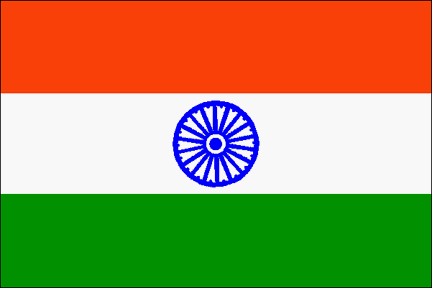





India's missile and nuclear weapons programs have evolved as elements of its strategic response to 50 years of wars and skirmishes it has fought with Pakistan and with China. Deep tensions and mistrust in the sub-continent continue unabated to the present. India's defeat by China in the 1962 border war, probably more than any other event, galvanized its leadership to build indigenous missile and "threshold" nuclear weapons capabilities as a credible deterrent against attack by China, and to attain military superiority over Pakistan.
The Indian missile program effectively began in 1967 as a space program and by 1972 had developed and test-fired the Rohini-560 two-stage, solid propulsion sounding rocket, which could reach an altitude of 334 km with a 100 kg payload. (1) A series of Rohini rockets, with varied ranges and payloads, were subsequently produced and are in service. (2) India first launched its small 17-ton SLV-3 space booster (300 km/40 kg) in 1979 and in 1980 successfully injected the 35 kg Rohini I satellite into near-earth orbit. (3) The SLV-3 may have been based on the U.S. Scout sounding rocket. (4) By 1987, an augmented booster, the 35-ton ASLV (4,000 km/150 kg in low earth orbit), which is basically three SLV-3's strapped together, had begun flight testing. While either of these boosters might threaten Pakistan and, the latter, China, as components of a ballistic missile, neither has intercontinental range. The much larger (275 ton) Polar Satellite Launch Vehicle (8,000 km/1,000 kg) is being developed to place in sun-synchronous polar orbit a one tonne satellite. The PSLV could readily deliver a nuclear warhead over intercontinental distances, if re-engineered as a weapon system. (5) Operational flights of this booster, originally planned for 1988, had been deferred until the mid-1990's, awaiting resolution of early ASLV launch failures. However, no reports of further PSLV progress have been noted as of August 1996.
India is also reported to be developing a Geosynchronous Satellite Launch Vehicle employing both solid and cryogenically fueled stages (the latter for upper stages). In January 1996, Russia was to start delivering seven cryogenic engines for the first seven flights of the GSLV; however, no confirmation of such deliveries has been reported. The U.S. pressured Russia to withdraw from the original agreement that would have provided India with one cryogenic engine and also transferred the rocket technology to build its own, such transfer a clear violation of the MCTR. With an expected range of 14,000 km and a payload of 2,500 kg, the GSLV would have an even greater potential than the PSLV as an ICBM. (6) However, a satellite launch system cannot be converted to an ICBM weapon system simply by substituting a nuclear warhead for the orbital payload. A change of mission from orbiting the earth to intersecting the earth requires extensive re-engineering of both ground and flight systems and, perhaps, a shift to military command and control.
Starting in 1983, India's Defence Research Development Organisation has dedicated considerable resources to the Integrated Guided Missile Development Programme (IGMDP). To date the IGMDP has sponsored the development of five missiles and their variants: Prithvi, Agni, Akash, Trishul, and Nag. DRDO has given particular priority to development of sophisticated guidance technologies.
The Akash is a long-range surface-to-air ramjet missile. It can carry a 55-kg multiple warhead capable of targeting five aircraft simultaneously up to 25 km and is said to be comparable to the U.S. Patriot as an air defense missile. User trials of the Akash were reported to be scheduled for 1996. The Trishul is a truck-mounted surface-to-air missile capable of delivering a 5.5-kg high explosive fragmented warhead a distance of 9 km. The fifth missile under IGMDP development is the Nag, an antiarmor weapon employing sensor fusion technologies for flight guidance over a range of about 4 km. It was first tested in November 1990. (8), (9)
U.S. pressure on India to reign in its missile developments and deployments is motivated not only by concerns about the dangers of an Indo-Sino-Pakistani arms race, but also by India's emergence as another potential proliferator of WMD. The missile progeny of the SLV boosters and some of other weapon developments noted can be configured to exceed MTCR restrictions. So far, India has not seemed particularly aggressive about marketing its weapon systems, probably because its domestic political turmoil has not allowed a consensus to develop on a national policy on weapon exports in the context of its national security and economic priorities. (10)
1. Onkar Marwak, "India's Nuclear and Space Programs: Intent and Policy," International Security, Vol. 2, No. 2, Fall 77, pp. 102-103.
2. The Nonproliferation Review, Winter 95, p. 160.
3. Jerrold F. Elkins and Brian Fredericks, "Military Implications of India's Space Program," Air University Review, Vol. 34, No. 3, May-June 83, pp. 56-63.
4. Gary Milhollin, "India's missiles with a little help from our friends," Bulletin of the Atomic Scientists, Nov 89, pp. 31-35.
5. David Wright, "The Development of Ballistic Missiles in Asia (Draft)," 18 Aug 92.
6. The Nonproliferation Review, op. cit.
8. The Washington Post, 8 Aug 94, p. A32.
9. "India Tests Variety of Antiarmor, Ballistic Missiles," Defense News, 25 Feb 91, p. 44.
10. "India Faces Roadblocks in Export Drive," Defense News, 18 Nov 91, p. 1.
